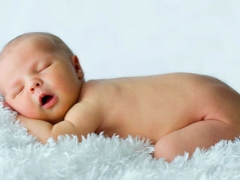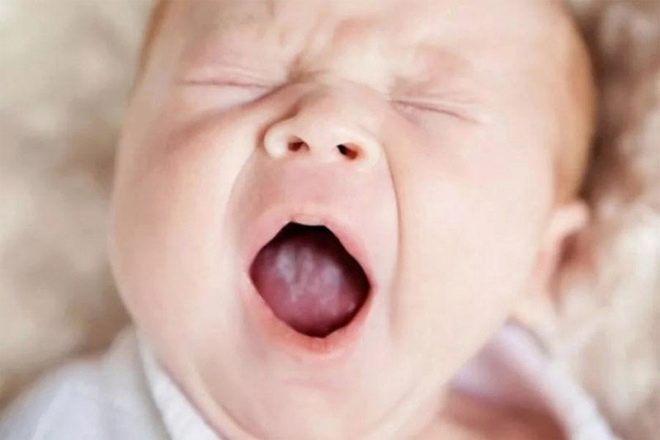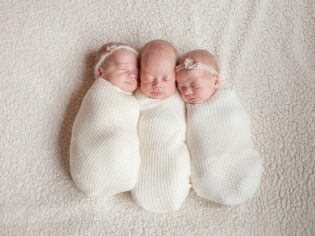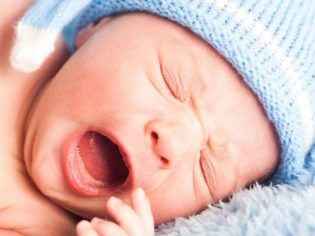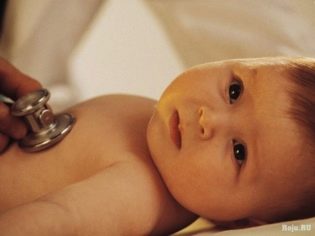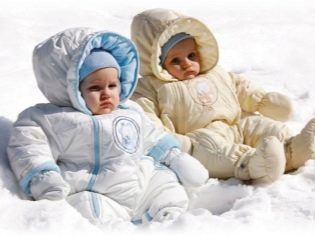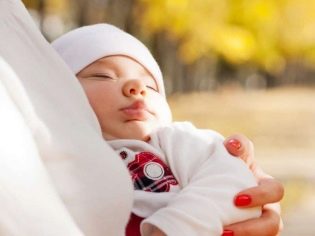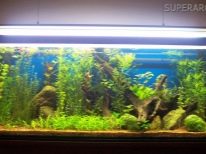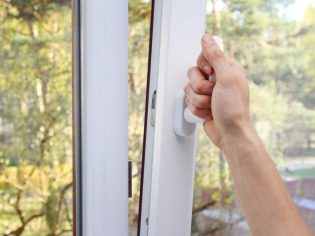Why do babies and babies often sneeze?
When the baby sneezes, the parents begin to look more closely, if the baby is sick. Grandmothers groan and gasp, complaining that the parents have caught a cold newborn. What dangers lurk in a tiny sneeze and why kids generally do it, we will tell in this article.
What is sneezing?
The child acquires the ability to sneeze even before his birth, but for the first time he can demonstrate this skill to the world only after birth, when the airways are filled with air.
Sneezing is an unconditioned reflex designed to protect a person from penetrating through the nose and nasopharynx of foreign and potentially dangerous bodies and microorganisms.
With the help of sneezing, the upper airways can get rid of dust that has accumulated in them, accumulated nasal mucus. Immediately before sneezing, the child experiences a tickling in the nose, takes a quick breath, fills the lungs with air, and there is a sharp forced exit through the nasopharynx.
The characteristic sound is formed due to the position of the tongue, and the glottis, the tongue rises, covers the nasopharynx. The intensity of exhalation at the level of the glottis at the same time in newborns and infants is very high - the air is pushed out at a speed of about 70-100 meters per second.
This entire fulminant process is regulated by special nerve cells at the level of the medulla oblongata. Receptors from the nasopharynx quickly transmit a signal through the nerve cells to the brain about the invasion of something that is in it, the nasopharynx, in no way, and the brain gives the command to decisively exile the uninvited guest out.
Sneezing newborn
Babies in the first months of life have a very convincing and compelling reason for sneezing. The nasal passages and lumens of the upper respiratory tract of the infant are very narrow, and the reflex act of sneezing is the only way to protect them from the negative effects of the environment.
The very first "sneeze" very often sounds even in the tribal hall. So baby trying to get rid of leftover mucusthat filled the nasopharynx while in the aquatic environment of the mother's womb. In the future, the baby may sneeze often, he has more than enough such reasons.
Usually intense sneezing continues. up to 3-4 months, then gradually goes into decline. The manifestation of this protective reflex does not always indicate a disease, but in all cases, without exception, it is a signal to the actions of the parents, because if the baby sneezes, then there is a reason that the mom and dad have to find.
The reasons
Physiological
Features of the structure of the nasal passages cause the fact of sneezing. But for parents, the true causes that trigger the reflex reaction mechanism remain unknown. And the most common and, by and large, completely harmless reasons lie in the fact that the mucous membranes of the child in the first 2-3 months of life are actively colonized by microflora.
Since immunity is still weak, the body reacts more vigilantly to germs, who are trying to settle in the nasopharynx. They have almost no chance to get to where they could show pathological activity.
The newborn sneezes less frequently. However, a child at 2-2.5 months may begin to sneeze almost constantly, this is due to the end of the process of colonization of microflora, now the baby's mucous membranes have become a little more like adults.
For natural reasons, the baby can and after feeding, if milk particles get into the nasopharynx during sucking.
There is evidence of a connection between the process of sucking and sneezing, and many medical scientists are confident that the very process of intensive sucking can irritate the receptors in the nasopharynx. Then an erroneous signal is sent to the brain and “sneeze” by and large occurs without a valid reason.
This whole natural process may be accompanied by the so-called physiological rhinitis. It is manifested by the fact that in a dream the baby is sniffing, sniffling.
Normally, the nasal mucus remains clear and fluid. If dry crusts began to form in the nose, the mucus thickened and changed color to yellow, yellow-green, gray-green, then this is a reason to think about the possible pathological causes of sneezing, such rhinitis cannot be considered normal and natural.
Pathological
Sneezing baby’s body often reacts to allergens in the nasopharynx. Such a runny nose is already considered allergic and may well be complicated by the addition of a bacterial infection.
You can distinguish the norm from the pathology on concomitant clinical symptoms. If a baby not only sneezes, but also coughs up, if the mucus thickens, and nasal breathing is difficult not only in sleep, but also during the day, when it is awake, if the child breathes through the mouth, then there is the possibility of an allergic nature of the phenomenon.
Immediately make a reservation that the allergy of the baby must have special genetic prerequisites. If mom or dad is allergic, then frequent sneezing with a violation of nasal breathing, red eye, tearing, coughing in the crumbs is most likely talking about allergies.
Allergens such as plant pollen, house dust, mold, flakes of skin from pet hair, tobacco smoke and even sharp mother's perfumery can cause such a reaction in infants. In response to the ingress of such particles, the baby’s body will react smoothly with a reflex loud “sneeze”.
Sneezing baby can start and at the starting stage of a viral diseaseand in this the grandmothers are partly right. But only partly, since parents are not guilty of ARVI and cannot be - no one is ever insured against viruses, and such illnesses are practically unrelated to hypothermia.
Such sneezing precedes the acute stage of the disease. In just a few hours, the baby may begin to fever, cough, and a liquid secret (snot) begins to flow out of the nose.
When a child begins to sneeze, the child's body tries to protect itself from viral agents caught in the nasopharynx, but it is usually impossible to get rid of them completely, the disease is rapidly developing and it’s not long to guess about the true causes, as the symptoms of ARVI will become obvious fairly quickly.
External
Making the child's body defend itself with a protective mechanism, such as sneezing, can anything from outside that goes into the nasopharynx. It may even be a villus from a diaper in which a crumb is dressed, or particles that have dried out because of too dry air in the nasal mucus room.
Most often children sneeze, which were born in the late fall and winter, because they have to spend the first weeks and months of independent life during the heating season.
Any heaters, radiators and other heating devices quickly and mercilessly dry the air, reduce its relative humidity. Even in a completely healthy baby, nasal mucus begins to dry out and force the receptors to send an alarm signal to the medulla oblongata again and again.
Stormy "sneeze" baby can react on the water in the nasopharynx while swimming, at a sharp temperature drop, for example, when leaving the house on the street for a walk, if it is winter and frost outside.
Very interesting mechanism for the development of reflex in response to a bright light. So, babies who endure in the sun, often begin to sneeze. Experts in the field of neurology claim that the optic nerve, being overexcited, sends the SOS signal through the same nerve paths as the receptors of the nasopharynx when foreign bodies penetrate it. Therefore, the decoding of the signal by the brain may be erroneous.
In case of injury of the nose, with unskillful attempts by parents to clean the nasal passages with turunds, it is also possible that such a reflex reaction.
Unlike physiological sneezing, the reflex provoked by external factors cannot be underestimated. If this factor cannot be found, the effect may continue, which may well lead to the appearance of swelling of the nasal passages.
Puffiness, drying and thickening of mucus will lead to disruption of normal nasal breathing, and the child will begin to breathe through his mouth, which in turn is fraught with drying up of bronchial secretions, the development of the inflammatory process in the upper and lower respiratory tracts, a complication such as pneumonia, bronchitis.
Appropriate measures should be taken to prevent this.
What if the baby sneezes?
If the baby sneezes and coughs, be sure to call the pediatrician, so as not to overlook the onset of a viral infection. It is impossible to prevent it, but at the earliest stages it is possible to help the child to survive the disease more painlessly.
If the baby sneezes and has no other signs of the disease, nasal breathing is not disturbed, the body temperature is normal, there is no cough, the appetite has not changed, there is no stool, then, most likely, nothing terrible happens.
The only difficulty in this case is to distinguish physiological sneezing from "sneezing" caused by adverse external factors. By and large, this is not required, it is enough to make external conditions favorable and conducive to the healthy development of the infant's respiratory organs, and the problem will be solved.
Moisturize the air
Make sure that in the room where the baby is sleeping, it was not too hot. If winter is in full swing, the batteries dry the air mercilessly, begin to humidify it. To do this, fit the device - humidifier. You do not have to buy an expensive ultrasound device, you can do with steam.
If there is no humidifier, and there is no opportunity to buy it from the family either, you can install an aquarium in the children's room or hang wet towels over the batteries and make sure that the fabric does not dry out every day.
It is useful to get a room thermometer and a hygrometer - a device for measuring the humidity of the air. In the child’s room, ideally, it should be no higher than 21 degrees Celsius, and the relative humidity of the air should be at the level of 50-70%.
You can adjust the temperature with the help of special control valves on the heating system. If the conditions are maintained within the specified limits, then the nasal mucus will not dry out, the child will breathe easier, and he will recover more quickly if he is sick.
It is better to refuse the idea of using a heater in the nursery. Especially it is necessary to be afraid of oil heaters which very quickly drain air in the room. If it seems that the baby is cold, it is better to warm it, but Do not heat the air in the room.
Air and do wet cleaning
Air the room where the baby lives, should be at least 2-3 times a day. It is better to do this before every sleep. During airing with a child, it is better to leave the nursery, and to return only when the air becomes fresh.
In winter, during the period of frosts, it is necessary to air only a couple of minutes, because too cold air is also dry, but in other seasons the ventilation time should be increased to 15-20 minutes.
Wet cleaning in the nursery do every day, while not using detergents. Especially dangerous household chemicals, which is composed of chlorine. It is this substance, getting into the air, which breathes the child, most often becomes the cause of allergies.
Declare a house dust war
In the room where the child sleeps, there should not be carpets, blankets with a long nap, large soft toys, since all these things accumulate very quickly and in large quantities dust, which not only causes the child to sneeze constantly, but also can cause a rather strong allergic reaction .
Dust accumulates in books, and therefore they can be stored in a room only in a closet behind glass. The leaves of houseplants should be wiped daily with a damp cloth, like all other surfaces.
Protect your child from allergens
Plant pollen and animal hair are not the best neighborhood for a newborn baby. Flowering plants and a cat with a dog, it is desirable to send to live in the next room or in the corridor.
Wash diapers baby, his vests and bedding should be only hypoallergenic baby powderwhose use is approved by dermatologists. If the baby is prone to allergies, then the same powder should be used to wash the clothes of all people who are in close contact with the baby, take it in their hands, help to care for it.
The clothes of the child should be made of natural fabrics, it should not be too bright. Bright things with multgeroyami - these are things that contain textile dyes.
It is best to give preference to the usual white vest and romper made of cotton and the same bed linen and diapers, and the child will have time to show off in bright fashionable things when she is a little older.
Do not give the baby medicine at its discretion, do not enter the supplements too early.
Nursing mom needs follow your own dietso that food allergens do not get into breast milk. It is advisable for an artificial artist to give only a fully adapted milk formula, if the means allow, then it is better to give preference to a hypoallergenic mixture in general.
Do not use soap and other children's skin care cosmetics too often. Mom should not actively use perfumes, especially if she is breastfeeding.
Water the child
Problems with the consistency of nasal mucus, as well as a host of other health problems of the child can be avoided, not forgetting to water the baby with ordinary boiled water from a bottle or a teaspoon more often.
It is advisable to give her baby between feedings. The amount of liquid is determined by the needs of the child: babies who are on artificial feeding of water should be given more than babies who eat mother's milk.
Flush nose
Do not bury the child vasoconstrictor drops, if he just sniffs. Firstly, a runny nose may be physiological, and, secondly, rapid drug addiction is developed for this group of drugs.
You can rinse the baby’s nose several times a day with a salt solution prepared at home from boiled water and salt, or with a ready-made pharmacy Aquamaris or saline. Do not use sprays for this, it is best to bury the liquid in the nasal passages using the most common medical pipette.
Protect your baby from bright light
Make sure that the sunlight does not “beat” to the eyes, so that the artificial light in the room is sufficient, but muffled. The organs of sight are not yet ready for such exertion, and sneezing in response to bright light is not the only reason to protect the child.
What not to do
Strictly prohibited:
- Smoking in the room where the baby is growing, as well as in the car in which it is being carried.
- Refuse to walk, if the kid cleared.Sneezing is a reason to go and get some fresh air away from car traffic and a lot of people, and not a reason to lock your baby at home for fear of hypothermia.
- It is wrong to use an aspirator to pump out excess nasal mucus. Repeated use of such a device increases the risk of infection.
- Warm up the room for fear that the baby gets sick.
The neonatologist Guzel Usmanova will tell you about why a newborn sneezes in the next video.
